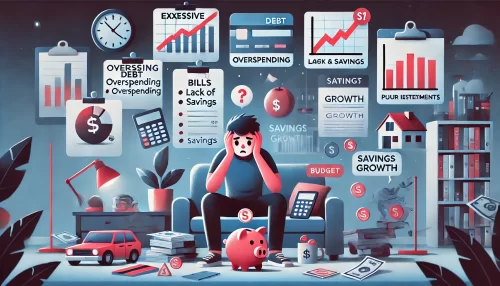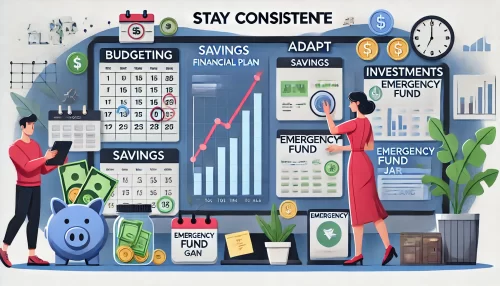Table of Contents
A solid financial plan isn’t just for the wealthy—it’s essential for anyone who wants financial security. Are you prepared for unexpected expenses? Do you know if your retirement savings will be enough? What if a sudden job loss or medical emergency puts your finances at risk? Without a clear plan, you could be jeopardizing your future without even realizing it.
The good news? You don’t need to be a financial expert to take control of your money. In this guide, we’ll break down why financial planning matters, the key components of a solid plan, and simple steps to help you build long-term stability. Let’s get started!
Why a Solid Financial Plan Is Essential for Your Future
A solid financial plan acts as your financial roadmap, helping you navigate life’s uncertainties and reach your long-term goals. Without one, you could face unnecessary stress, debt, and missed opportunities. Let’s explore the consequences of poor financial planning, how having a plan ensures stability, and how it contributes to wealth building.
Understanding the Consequences of Poor Financial Planning
Neglecting financial planning creates instability, increases debt, and leads to financial hardship. Many people live paycheck to paycheck without realizing how vulnerable they are to unexpected expenses or economic downturns. Without a structured approach, financial security becomes difficult to achieve.
Failing to track expenses often results in overspending. Small purchases may seem insignificant, but they add up quickly. Without a clear plan, savings suffer, leaving no buffer for emergencies such as medical bills, car repairs, or job loss.
Debt also spirals out of control when financial decisions lack direction. Credit card balances, student loans, and high-interest personal loans become overwhelming, making it hard to break free. Relying on credit to make ends meet leads to a cycle that’s difficult to escape.
Long-term financial goals—such as homeownership, retirement, and investing—often get pushed aside when there’s no plan in place. Many assume there’s time to start saving later, but delaying financial planning limits the ability to benefit from compound interest and long-term growth.
Beyond financial struggles, stress and anxiety increase when money is uncertain. Constant worry about bills, debt, or unexpected expenses affects mental well-being, strains relationships, and lowers overall quality of life. Choosing a solid financial plan removes uncertainty and brings peace of mind.
How a Solid Financial Plan Helps You Achieve Stability
Financial stability isn’t about how much you earn—it’s about how well you manage what you have. A structured plan ensures income, expenses, and savings work together, creating a foundation strong enough to handle unexpected situations without jeopardizing long-term security.
A well-designed budget builds that stability. Tracking income and expenses prevents unnecessary spending and keeps financial goals on track. A spending plan helps balance necessary expenses with enjoyable experiences while maintaining financial health.
An emergency fund is another essential element. Experts recommend saving at least three to six months’ worth of living expenses in an accessible account. This safety net prevents financial disruptions during job loss, medical emergencies, or major repairs.
Debt management plays a crucial role in financial stability. Paying off high-interest debt first reduces financial strain, preventing unnecessary interest payments. Avoiding new debt whenever possible allows savings and investments to grow without constant financial setbacks.
Choosing clear financial goals provides direction and motivation. Whether saving for a home, funding education, or preparing for retirement, structured planning ensures that aspirations become reality instead of distant dreams. Financial stability allows for peace of mind, reducing stress and creating opportunities for growth.
The Role of Financial Planning in Wealth Building
Wealth doesn’t happen overnight—it’s built through smart financial decisions and intentional planning. A structured approach to saving, investing, and spending allows for long-term financial security and growth.
Automating savings makes a significant difference. Setting up automatic transfers to savings and investment accounts removes the temptation to spend extra money and ensures consistent contributions.
Investing wisely accelerates wealth-building efforts. Allocating funds to stocks, real estate, or retirement accounts allows money to grow over time. Spreading investments across multiple assets reduces risk while maximizing returns.
Retirement planning remains one of the most effective ways to create long-term financial stability. Contributing to tax-advantaged accounts such as a 401(k) or IRA ensures a comfortable future. Starting early provides a significant advantage, as compound interest increases the value of contributions over time.
Mindful spending also plays a key role in wealth accumulation. Many assume a higher income automatically leads to wealth, but poor spending habits prevent financial growth. Avoiding lifestyle inflation—where expenses increase with income—preserves wealth and accelerates financial freedom.
Discipline and consistency create long-term success. Sticking to a structured financial plan, making informed investment choices, and eliminating unnecessary debt set the foundation for lasting financial independence.
Common Myths About Financial Planning That Hold You Back
Many avoid financial planning due to misconceptions that make it seem overwhelming or unnecessary. These myths prevent people from taking control of their finances and securing their future.
One of the biggest misconceptions is that financial planning is only for the wealthy. In reality, structured money management benefits everyone, regardless of income level. Establishing good habits ensures financial stability and reduces stress.
Another common belief is that budgeting means sacrificing enjoyable experiences. A well-balanced financial plan allows for both necessities and entertainment while keeping long-term goals on track.
Some fear investing due to perceived risks or complexity. While all investments carry some level of risk, making informed choices and diversifying investments helps minimize potential losses. Understanding different investment strategies increases confidence and financial growth.
Many assume it’s too late to start financial planning. While starting early provides advantages, it’s never too late to improve financial health. Adjusting spending habits, focusing on debt repayment, and making smart investment choices create long-term security at any stage of life.
Another misconception is that professional financial advice isn’t necessary. While not everyone needs a financial advisor, expert guidance can provide clarity and direction, especially when dealing with major financial decisions or long-term planning.
Breaking free from these myths allows for a clearer, more confident approach to money management. Choosing financial planning means taking control, removing uncertainty, and creating a future with financial freedom.
Pro Tip: Take small, intentional steps. Setting aside a portion of income for savings, eliminating unnecessary expenses, and creating a budget today builds long-term financial security and peace of mind.
Key Components of a Solid Financial Plan

A solid financial plan isn’t just about saving money—it’s about creating a roadmap that ensures financial security and long-term success. Without structure, managing finances can feel overwhelming, leading to missed opportunities and financial instability.
Establishing clear financial goals, building a realistic budget, and managing debt effectively are essential steps toward long-term financial well-being.
Setting Clear Financial Goals for Long-Term Success
Without a defined financial goal, money often gets spent without direction, leading to financial stagnation. Setting clear goals provides a sense of purpose and motivation, making it easier to make smart financial decisions. Whether the focus is on short-term stability or long-term wealth, structured planning creates the momentum needed for success.
Financial goals fall into two main categories: short-term and long-term. Short-term goals, such as building an emergency fund or paying off a small debt, create immediate financial relief. Long-term goals, like homeownership, retirement savings, or investment growth, require consistent planning and commitment. Defining these objectives ensures that every financial decision aligns with a larger vision.
A practical approach to setting financial goals involves using the SMART framework—Specific, Measurable, Achievable, Relevant, and Time-bound. For example, instead of saying, “I want to save more money,” a SMART goal would be: “I will save $5,000 in an emergency fund within 12 months by setting aside $420 per month.” This method adds clarity and accountability.
Prioritizing financial goals prevents frustration. Trying to tackle multiple objectives at once can feel overwhelming. Identifying what matters most—whether reducing debt, increasing savings, or investing—helps focus energy and resources on meaningful progress.
Tracking progress keeps motivation high. Regularly reviewing financial goals ensures adjustments can be made as needed. Life circumstances change, and financial plans should adapt accordingly. Having a clear financial strategy allows for flexibility without sacrificing long-term success.
Budgeting: The Foundation of a Strong Financial Plan
A well-crafted budget creates financial stability by ensuring income covers essential expenses while leaving room for savings and discretionary spending. Without a budget, spending often exceeds income, leading to financial stress and debt accumulation.
A strong budgeting strategy starts with tracking income and expenses. Understanding where money is going each month highlights unnecessary spending habits and opportunities for savings. Apps and spreadsheets help simplify expense tracking, making budgeting more manageable.
Categorizing expenses makes budgeting more effective. Essential costs, such as housing, food, and utilities, should be prioritized before allocating money to discretionary expenses. An ideal budgeting framework follows the 50/30/20 rule—50% for needs, 30% for wants, and 20% for savings or debt repayment. Adjustments can be made based on personal financial circumstances.
Building a buffer for unexpected expenses prevents financial disruptions. Even a well-planned budget can be thrown off by medical bills, car repairs, or job loss. Allocating a portion of income to an emergency fund ensures financial security during unpredictable situations.
Flexibility is key in long-term budgeting success. A rigid budget can feel restrictive, making it difficult to stick to over time. Allowing for adjustments while maintaining financial discipline ensures a budget remains effective without feeling overwhelming.
Managing Debt Effectively to Avoid Financial Pitfalls
Debt can either be a tool for financial growth or a burden that limits financial freedom. Understanding how to manage debt strategically ensures it doesn’t become an obstacle to achieving financial goals. A structured debt repayment strategy prevents unnecessary financial strain and improves long-term financial health.
Prioritizing high-interest debt accelerates financial progress. Credit card balances and payday loans often come with high interest rates that compound over time, making them more expensive in the long run. Focusing on paying off these debts first reduces financial stress and frees up money for savings and investments.
Choosing a structured repayment strategy simplifies debt management. The snowball method focuses on paying off the smallest debt first while making minimum payments on larger debts, creating a psychological boost as balances are eliminated. The avalanche method prioritizes debts with the highest interest rates first, saving money on interest over time. Each approach provides a strategic path to becoming debt-free.
Avoiding unnecessary debt prevents financial setbacks. While loans for education, housing, or business investments can be beneficial, excessive credit card use and personal loans without a clear repayment plan can create financial strain. Evaluating whether a purchase is necessary before taking on debt ensures responsible borrowing.
Consolidating debt can provide relief. Combining multiple debts into a single loan with a lower interest rate simplifies payments and reduces financial stress. While not always the best option, debt consolidation can help manage high-interest balances more efficiently.
Building a habit of paying off balances in full prevents future debt accumulation. Credit cards offer convenience and rewards, but carrying a balance leads to high-interest charges. Making on-time payments and limiting credit use to manageable amounts helps maintain financial control.
The Importance of Emergency Savings for Financial Security
An emergency fund is the backbone of a solid financial plan, acting as a financial safety net during unexpected situations. Without it, even a small financial setback—like a medical bill, car repair, or sudden job loss—can cause significant stress and disrupt financial stability. A well-funded emergency savings account prevents reliance on high-interest credit cards or loans during challenging times.
A strong emergency fund covers at least three to six months’ worth of living expenses. This ensures essential costs—such as rent, utilities, groceries, and insurance—are taken care of even if income stops temporarily. For those with fluctuating income, such as freelancers or business owners, saving closer to six or nine months’ worth of expenses adds extra security.
Choosing the right account for emergency savings matters. A high-yield savings account provides accessibility while earning interest, helping money grow without being exposed to risk. While investing emergency funds in stocks may seem tempting, quick access to cash is essential during financial emergencies, making a traditional savings account the safer choice.
Building an emergency fund takes time, but consistency is key. Setting up automatic transfers to a dedicated savings account each month ensures steady progress. Even small contributions, such as $50 or $100 per paycheck, add up over time, creating a reliable cushion against financial uncertainty.
Tapping into emergency savings should only happen when absolutely necessary. Using this fund for non-emergency expenses can quickly deplete financial security, making it harder to recover when a real emergency occurs. Keeping clear guidelines on when to use these savings helps maintain financial discipline and long-term security.
Retirement Planning: Ensuring a Comfortable Future
A solid financial plan includes preparing for the future, and retirement planning plays a crucial role in long-term financial security. Without a structured retirement strategy, many individuals risk outliving their savings, leading to financial struggles later in life. Starting early and making consistent contributions help ensure a comfortable and worry-free retirement.
The power of compound interest makes early retirement savings highly beneficial. Contributing to retirement accounts in the early years of a career allows investments to grow exponentially over time. Even modest monthly contributions can lead to substantial savings due to the compounding effect.
Choosing the right retirement accounts maximizes financial benefits. Employer-sponsored plans, such as a 401(k), often include contribution matches, essentially offering free money that accelerates savings growth. For those without access to a 401(k), an IRA (Individual Retirement Account) provides a tax-advantaged way to save. Deciding between a traditional or Roth IRA depends on whether tax benefits are preferred now or during retirement.
Calculating retirement needs ensures adequate savings. Many financial experts suggest aiming to replace at least 70-80% of pre-retirement income. Factoring in healthcare, inflation, and lifestyle goals helps determine the right savings target. Retirement calculators offer valuable insights into how much should be saved each month to reach financial goals.
Staying consistent with contributions—even during financial hardships—prevents setbacks. While it may be tempting to reduce or stop saving during challenging times, maintaining retirement contributions as much as possible keeps financial goals on track. Adjusting investments and reassessing retirement goals ensures continued progress toward a secure future.
Investing Strategies to Build and Preserve Wealth
Growing wealth requires more than just saving—it demands smart investment choices that allow money to work over time. A solid financial plan includes a well-diversified investment strategy that balances risk and return, ensuring steady financial growth while protecting assets from market fluctuations.
Diversification is key to minimizing risk. Spreading investments across different asset classes—such as stocks, bonds, real estate, and index funds—ensures that market downturns in one area don’t wipe out an entire portfolio. A diversified approach provides stability while capturing growth opportunities.
Understanding risk tolerance helps guide investment decisions. Younger investors often have a higher risk tolerance, allowing them to invest in higher-growth assets such as stocks. Those closer to retirement typically shift toward lower-risk options like bonds or dividend-paying stocks to protect accumulated wealth. Balancing growth with security ensures financial success over time.
Consistent investing—even during market downturns—produces long-term rewards. Market fluctuations are inevitable, but staying invested and continuing to contribute prevents panic-driven decisions. Dollar-cost averaging, which involves investing a fixed amount at regular intervals, reduces the impact of market volatility and builds wealth steadily.
Regularly rebalancing an investment portfolio ensures it aligns with financial goals. Over time, certain investments may outperform others, leading to an unbalanced asset allocation. Reviewing and adjusting investments annually maintains diversification and keeps the portfolio on track for financial success.
Investing for wealth preservation matters just as much as wealth accumulation. Protecting gains through conservative investments, estate planning, and proper asset allocation ensures financial security for future generations. A solid financial plan includes strategies to sustain financial growth while minimizing unnecessary risks.
Estate Planning: Protecting Your Assets for Future Generations
Estate planning isn’t just for the wealthy—it’s a critical step in securing a financial legacy and ensuring assets are distributed according to personal wishes. Without a structured estate plan, legal complications, high taxes, and family disputes can arise, putting financial stability at risk.
Creating a will is the foundation of estate planning. A legally binding will outlines asset distribution, appoints guardians for minors, and prevents the state from making financial decisions on behalf of an estate. Without one, assets may be divided through a lengthy and costly probate process.
Choosing a power of attorney ensures financial and medical decisions are handled properly. Assigning a trusted individual to manage affairs in the event of incapacity prevents financial disruptions and ensures personal wishes are respected. A healthcare proxy also safeguards medical choices if an individual is unable to make decisions themselves.
Setting up a trust offers greater control over asset distribution. Trusts help avoid probate, reduce estate taxes, and protect beneficiaries from financial mismanagement. Revocable trusts allow changes during a lifetime, while irrevocable trusts provide stronger asset protection. Consulting an estate planning attorney helps determine the best option.
Minimizing estate taxes preserves wealth for future generations. Strategies such as gifting assets during one’s lifetime, setting up charitable donations, or utilizing tax-advantaged accounts reduce financial burdens on heirs. Proper tax planning ensures more wealth stays within the family rather than being lost to government fees.
Regularly updating an estate plan ensures it reflects current financial circumstances and legal requirements. Life changes—such as marriage, divorce, new children, or significant financial shifts—necessitate revisions to ensure assets are protected and distributed according to personal wishes. A proactive approach keeps financial security intact for loved ones.
Expert Tip: Estate planning isn’t just about distributing assets—it’s about ensuring financial stability for future generations. Taking time to create a structured estate plan provides peace of mind, protects wealth, and ensures loved ones are cared for in the long run.
How to Create a Solid Financial Plan That Works for You

A solid financial plan isn’t just about setting goals—it’s about creating a clear and personalized strategy that fits your lifestyle, income, and future aspirations. Without structure, managing money can feel overwhelming, leading to poor financial decisions and missed opportunities.
Taking the time to assess your current situation, define your financial goals, and craft a realistic budget ensures long-term stability and financial success.
Assessing Your Current Financial Situation and Net Worth
Understanding where you stand financially is the first step in building a solid financial plan. Without a clear picture of income, expenses, assets, and debts, making informed financial decisions becomes difficult. A financial assessment provides the foundation needed to create a strategy that works.
Start by calculating your net worth, which is the difference between your assets and liabilities. Assets include savings, investments, real estate, and valuable possessions, while liabilities consist of debts such as loans, credit card balances, and mortgages. A positive net worth indicates financial stability, while a negative net worth suggests the need for adjustments to reduce debt and increase savings.
Tracking income and expenses offers insight into spending habits. Reviewing bank statements, credit card bills, and receipts for the past three to six months helps identify patterns. Many people are surprised to discover how much they spend on non-essential items. Recognizing these habits allows for smarter financial choices moving forward.
Identifying high-interest debts that drain financial resources is crucial. Credit cards and payday loans often come with steep interest rates that make repayment challenging. Focusing on eliminating these debts frees up income for savings and investments, strengthening financial security over time.
Evaluating financial risks ensures better preparedness. Life is unpredictable, and unexpected situations—such as medical emergencies, job loss, or home repairs—can quickly destabilize finances. Checking insurance coverage, setting up an emergency fund, and planning for worst-case scenarios provide peace of mind and prevent financial setbacks.
Identifying Short-Term and Long-Term Financial Goals
Setting clear financial goals gives direction and purpose to a financial plan. Without specific objectives, money often gets spent aimlessly, delaying financial progress. Defining both short-term and long-term goals creates a balanced approach that ensures financial security and growth.
Short-term goals focus on immediate financial improvements, usually within one to three years. These may include building an emergency fund, paying off credit card debt, or saving for a vacation. Achieving short-term goals provides a sense of accomplishment and motivation to continue financial planning.
Long-term goals require sustained effort and planning. Buying a home, funding a child’s education, or saving for retirement are examples of objectives that take decades to achieve. The earlier these goals are set, the easier they become to accomplish due to compound growth and consistent contributions.
Prioritizing financial goals prevents overwhelming financial pressure. Trying to tackle multiple objectives at once can dilute efforts and slow progress. Focusing on a few key priorities—such as eliminating debt before investing heavily—helps build a strong financial foundation.
Setting SMART financial goals ensures better follow-through. Goals should be Specific, Measurable, Achievable, Relevant, and Time-bound. Instead of saying, “I want to save more money,” a better goal is, “I will save $10,000 for a house down payment within two years by setting aside $415 per month.” A structured approach turns vague ideas into concrete steps.
Tracking progress regularly keeps financial goals on track. Life circumstances change, and financial strategies should adapt accordingly. Reviewing goals every few months ensures they remain relevant and realistic while allowing for necessary adjustments.
Crafting a Realistic Budget That Aligns With Your Lifestyle
A budget is the backbone of a solid financial plan, ensuring that income covers essential expenses, savings, and discretionary spending. Without a structured budget, financial planning can quickly fall apart, leading to overspending, debt accumulation, and financial stress.
The first step in budgeting is categorizing expenses. Essential costs—such as rent or mortgage payments, utilities, groceries, and insurance—should always come first. Discretionary spending, such as dining out, entertainment, and shopping, should be managed carefully to prevent financial strain.
Using the 50/30/20 rule provides a simple yet effective budgeting framework. This method allocates 50% of income to necessities, 30% to wants, and 20% to savings or debt repayment. Adjusting these percentages based on individual financial goals ensures a personalized budget that remains practical.
Tracking expenses helps maintain financial discipline. Many people underestimate how much they spend on small, everyday purchases. Using budgeting apps or spreadsheets provides a clear breakdown of spending patterns, making it easier to identify areas where costs can be reduced.
Building a budget that includes flexibility prevents frustration. A rigid budget often leads to burnout, causing people to abandon financial planning altogether. Allocating some funds for spontaneous spending—while still meeting savings goals—creates a balanced approach that is easier to maintain long-term.
Automating savings simplifies budgeting and ensures consistency. Setting up automatic transfers to savings accounts or investment funds removes the temptation to spend extra money. When savings become a non-negotiable expense, financial security improves naturally over time.
Adapting a budget as income changes ensures continued success. Salary increases, unexpected expenses, or shifts in financial priorities require budget adjustments. Regularly reviewing and refining a budget helps maintain control over finances and prevents unnecessary stress.
Choosing the Right Investment Options for Growth
A solid financial plan goes beyond just saving—it requires strategic investing to grow wealth over time. Simply keeping money in a savings account isn’t enough to outpace inflation. Choosing the right investment options ensures financial growth while balancing risk and stability.
Understanding risk tolerance helps determine the best investment approach. Those with a higher risk tolerance may focus on stocks, which offer strong long-term returns but come with volatility. More conservative investors may prefer bonds or dividend-paying stocks, which provide steady income with lower risk. Finding the right balance between growth and security ensures long-term success.
Diversification protects investments from market downturns. Spreading money across different asset classes—such as stocks, bonds, real estate, and mutual funds—reduces risk by ensuring that poor performance in one area doesn’t significantly impact overall financial health. A well-diversified portfolio creates resilience and stability.
Choosing tax-advantaged accounts maximizes investment returns. Contributing to retirement accounts like a 401(k) or IRA allows money to grow tax-free or tax-deferred, making them essential tools for wealth building. For non-retirement investments, options like index funds and ETFs provide a cost-effective way to participate in market growth without excessive fees.
Investing consistently—even during market fluctuations—produces long-term rewards. The stock market experiences ups and downs, but maintaining a steady investment strategy prevents emotional decisions that can lead to financial losses. Dollar-cost averaging, which involves investing a fixed amount regularly, smooths out market volatility and builds wealth over time.
Regularly reviewing investments ensures alignment with financial goals. Over time, market conditions change, and some investments may outperform others. Rebalancing a portfolio—adjusting allocations to maintain the desired risk level—keeps financial plans on track and prevents unnecessary exposure to market downturns.
Strategies for Reducing Debt and Increasing Savings
Debt management plays a crucial role in achieving financial stability. Without a clear strategy, high-interest loans and credit card balances can prevent financial growth. Reducing debt while simultaneously increasing savings strengthens long-term financial security.
Focusing on high-interest debt first accelerates financial progress. Credit card debt, payday loans, and personal loans often carry high-interest rates that make them difficult to pay off. Eliminating these first reduces financial strain and frees up money for savings and investments.
Choosing a structured debt repayment strategy creates consistency. The snowball method prioritizes paying off smaller debts first, creating psychological motivation, while the avalanche method focuses on high-interest debts, saving more money over time. Both methods provide a clear path to debt freedom.
Increasing income sources speeds up debt repayment and savings contributions. Taking on freelance work, selling unused items, or starting a side business generates extra cash that can be directed toward financial goals. Finding ways to increase income—while maintaining controlled spending—accelerates financial success.
Automating savings prevents money from being spent impulsively. Setting up automatic transfers to savings accounts ensures consistent contributions without requiring effort. Even small, regular savings deposits accumulate over time, creating long-term financial stability.
Cutting unnecessary expenses increases available funds for debt repayment and savings. Reviewing spending habits and identifying non-essential costs—such as subscriptions, dining out, or impulse purchases—creates additional resources to allocate toward financial growth. Small adjustments lead to significant improvements in financial health.
How to Continuously Review and Adjust Your Financial Plan
A solid financial plan isn’t a one-time effort—it requires regular adjustments to keep up with changing circumstances, market conditions, and life goals. Without periodic reviews, financial progress can slow, and plans may become outdated. Staying proactive ensures continued success.
Setting regular financial check-ins keeps progress on track. Reviewing budgets, expenses, savings, and investment performance every few months ensures financial strategies remain aligned with goals. Life events—such as marriage, career changes, or new expenses—require financial adjustments to maintain stability.
Updating financial goals ensures they stay relevant. As financial situations evolve, goals may shift. Someone initially focused on debt repayment may transition to wealth-building strategies once financial burdens decrease. Revisiting goals regularly ensures priorities align with current needs.
Rebalancing investments maintains risk tolerance and portfolio health. Over time, certain investments may outperform others, leading to an unbalanced allocation. Adjusting portfolios annually prevents overexposure to high-risk assets while ensuring continued financial growth.
Adapting spending habits prevents financial stagnation. Lifestyle inflation—where expenses increase as income grows—can slow financial progress. Continuously evaluating spending patterns ensures money is allocated efficiently, allowing for both enjoyment and financial security.
Seeking professional financial advice when needed strengthens financial decision-making. Consulting with a financial advisor during major life transitions—such as retirement planning, home purchases, or investment adjustments—provides expert insights that prevent costly mistakes and enhance financial strategies.
Expert Tip: Set a reminder to review your financial plan every six months. Regularly assessing savings, debt, and investment progress ensures financial strategies remain effective and adaptable to life’s changes.
Common Financial Mistakes That Can Derail Your Future

A solid financial plan is only effective if common financial mistakes are avoided. Many people unknowingly make errors that sabotage long-term stability, leading to financial stress and setbacks. Ignoring budgeting, delaying retirement planning, neglecting emergency savings, and mismanaging debt are just a few pitfalls that can undermine financial security.
Understanding these mistakes and taking proactive steps to correct them ensures a more secure financial future.
Ignoring Budgeting and Overspending Beyond Your Means
Budgeting is the foundation of financial stability, yet many people avoid it, assuming it’s restrictive or unnecessary. Without a clear spending plan, money often disappears into unnecessary expenses, making it difficult to save or invest effectively. Financial success depends on tracking income and expenses to ensure spending aligns with personal goals.
Spending beyond one’s means often leads to financial stress. Lifestyle inflation—where expenses rise alongside income—prevents savings from growing. Instead of increasing spending with every pay raise, prioritizing savings and investments ensures financial progress. Small daily expenses, like frequent dining out or impulse purchases, can accumulate quickly and drain financial resources.
A well-structured budget helps maintain financial discipline. Using the 50/30/20 rule—allocating 50% of income to necessities, 30% to discretionary spending, and 20% to savings or debt repayment—ensures balance. Sticking to a structured budget prevents overspending while allowing for financial flexibility.
Tracking expenses provides insight into spending patterns. Many people underestimate their non-essential purchases, such as streaming subscriptions, luxury items, or convenience services. Reviewing transactions monthly helps identify areas where costs can be cut without sacrificing financial goals.
Ignoring budgeting also makes it harder to achieve major financial milestones. Homeownership, early retirement, or debt freedom requires intentional financial planning. Without a structured approach, these aspirations remain out of reach. Creating and following a personalized budget prevents financial stagnation and ensures steady progress.
Failing to Plan for Retirement Early Enough
Delaying retirement planning is one of the most common financial mistakes. Many assume there’s plenty of time to save, but postponing contributions significantly reduces the ability to build long-term wealth. Compound interest works best over time, making early contributions essential for maximizing retirement savings.
Starting early requires less effort to achieve financial independence. Someone who begins investing in their 20s needs to save significantly less per month than someone who starts in their 40s to reach the same goal. The longer money is invested, the more it benefits from exponential growth.
Relying solely on Social Security or employer pensions is risky. Many people underestimate how much they’ll need in retirement, assuming external sources will cover expenses. Inflation, healthcare costs, and unexpected expenses can quickly erode savings, making personal contributions essential for financial security.
Choosing the right retirement accounts accelerates savings. Employer-sponsored 401(k) plans often include matching contributions, effectively doubling savings at no extra cost. For those without employer options, an IRA (Individual Retirement Account) provides tax advantages that boost long-term growth. Consistently contributing ensures a comfortable future.
Regularly reviewing retirement goals prevents shortfalls. Life circumstances change, and financial plans should adapt accordingly. Increasing contributions as income rises, adjusting asset allocations, and monitoring retirement projections help maintain financial stability and ensure long-term success.
Neglecting Emergency Funds and Unexpected Expenses
An emergency fund is a financial safety net, yet many people overlook its importance. Without savings dedicated to unexpected expenses, even minor emergencies—such as car repairs or medical bills—can disrupt financial stability. Relying on credit cards or loans in these situations creates unnecessary debt and financial stress.
Experts recommend saving three to six months’ worth of living expenses in an easily accessible account. This ensures financial security in case of job loss, illness, or unexpected costs. Those with variable income, such as freelancers or entrepreneurs, may benefit from a larger emergency fund for added stability.
Choosing the right place to store emergency savings matters. A high-yield savings account offers easy access while earning interest, making it an ideal option. Investing emergency funds in stocks or long-term assets can make withdrawals difficult, leading to financial strain during urgent situations.
Automating contributions ensures steady growth. Treating emergency savings like a fixed expense makes it easier to build financial security. Even setting aside a small percentage of each paycheck consistently creates a reliable cushion over time.
Using emergency funds only for actual emergencies prevents depletion. Tapping into savings for non-essential purchases—such as vacations or luxury items—defeats its purpose. Maintaining financial discipline ensures this fund remains available when it’s truly needed.
Relying Too Much on Credit and Accumulating Debt
Credit cards offer convenience, but excessive reliance on them can create long-term financial problems. Carrying high balances with high-interest rates makes it difficult to achieve financial stability. Without a structured repayment plan, debt can quickly spiral out of control.
Minimum payments keep debt lingering for years. Many credit card users only pay the minimum amount due, unaware that interest compounds over time. Paying off the full balance each month prevents unnecessary interest charges and keeps financial health in check.
Understanding the difference between good and bad debt helps make informed financial choices. Loans for education, home purchases, or business investments can build wealth, while consumer debt—such as credit card balances and payday loans—often leads to financial strain. Managing debt wisely ensures long-term security.
Developing a repayment strategy accelerates financial progress. The snowball method focuses on paying off the smallest debt first for quick wins, while the avalanche method targets high-interest debt first, saving money over time. Choosing a strategy that fits personal financial goals ensures debt elimination.
Avoiding unnecessary credit applications prevents financial pitfalls. Frequent borrowing, especially without a clear repayment plan, increases financial stress. Limiting new credit and focusing on reducing existing debt improves overall financial stability.
Not Diversifying Investments and Taking Unnecessary Risks
Putting all money into a single investment increases risk and reduces financial security. Many investors make the mistake of relying solely on one asset type—such as stocks, real estate, or cryptocurrency—without considering diversification. A solid financial plan includes a mix of investments to minimize losses and maximize growth.
Diversification spreads risk across multiple asset classes. Stocks, bonds, real estate, and index funds all react differently to market conditions. A well-balanced portfolio ensures that a downturn in one area doesn’t significantly impact overall financial health.
Overexposure to high-risk investments can lead to major financial losses. While high-reward assets like individual stocks or speculative investments may seem attractive, they come with volatility. Allocating only a portion of funds to high-risk assets while maintaining safer investments provides financial protection.
Regular portfolio reviews ensure investments stay aligned with financial goals. Market fluctuations and life changes may require adjustments. Rebalancing investments periodically maintains diversification and risk levels.
Understanding investment time horizons helps make better decisions. Short-term financial needs should not be tied to high-risk investments. Keeping emergency funds and short-term savings in stable, low-risk accounts prevents financial setbacks.
Avoiding Professional Financial Advice and Guidance
Many people believe they can manage their finances alone, but seeking expert guidance strengthens financial decision-making. Professional financial advisors offer insights that help avoid costly mistakes and optimize financial strategies. Ignoring expert advice often leads to missed opportunities and unnecessary financial risks.
Financial advisors provide personalized strategies tailored to individual goals. Whether planning for retirement, investing, or managing debt, professionals offer expertise that enhances financial outcomes. Consulting with a trusted advisor ensures money is managed effectively.
Choosing the right financial professional ensures quality advice. A certified financial planner (CFP) or fiduciary advisor acts in the client’s best interest, unlike commission-based advisors who may prioritize their earnings. Researching credentials and understanding fee structures prevents conflicts of interest.
Regular financial check-ins with an advisor keep financial plans on track. Life circumstances change, and professional guidance helps adjust strategies accordingly. Even a yearly consultation ensures financial goals remain aligned with personal aspirations.
While professional guidance is beneficial, staying informed is equally important. Educating oneself on personal finance topics—such as investing, tax planning, and debt management—empowers individuals to make smarter financial choices.
Expert Tip: Financial success requires continuous learning and adaptability. Regularly reviewing and improving financial strategies prevents common mistakes, ensuring long-term stability and security.
The Benefits of Seeking Professional Financial Advice
A solid financial plan provides structure, but professional guidance enhances its effectiveness. Many people believe managing money alone is enough, yet financial advisors offer valuable expertise that prevents costly mistakes and maximizes long-term gains. Seeking professional advice helps navigate complex financial decisions, optimize investment strategies, and ensure financial goals stay on track.
How a Financial Advisor Can Help You Achieve Your Goals
Financial advisors play a critical role in helping individuals develop and maintain a structured financial plan. Their expertise extends beyond simple budgeting—covering areas like investments, tax strategies, retirement planning, and debt management. Whether starting out or looking to grow wealth, expert insights can significantly improve financial outcomes.
One of the greatest benefits of working with a financial advisor is personalized planning. Rather than offering generic advice, they assess individual financial situations, goals, and risk tolerance to create a strategy tailored to specific needs. This ensures financial decisions align with both short-term stability and long-term growth.
Investment guidance is another key advantage. The stock market, real estate, and other investment opportunities can be overwhelming. A financial advisor helps select assets that match personal risk tolerance and financial objectives, ensuring a diversified portfolio that minimizes losses and maximizes returns.
Tax optimization strategies help individuals keep more of what they earn. Many people unknowingly overpay in taxes due to poor planning. Financial advisors suggest tax-efficient investment options, recommend retirement accounts with tax advantages, and provide strategies to reduce taxable income legally.
For those nearing retirement, financial advisors ensure long-term security. They help determine sustainable withdrawal rates, manage retirement accounts efficiently, and protect savings against inflation. This ensures financial stability throughout retirement while preventing unnecessary financial stress.
When to Consider Hiring a Financial Planner
Not everyone needs a financial planner, but there are key moments when professional guidance becomes invaluable. Recognizing when to seek advice can prevent financial setbacks and ensure smarter money management.
Major life events often require financial expertise. Getting married, buying a home, having children, or starting a business all impact financial planning. A financial advisor helps navigate these transitions, ensuring financial decisions align with long-term goals.
Significant changes in income also warrant professional advice. Whether receiving a salary increase, an inheritance, or a lump sum from selling a business, a financial planner ensures money is allocated wisely to maximize long-term benefits. Without strategic planning, sudden wealth can be mismanaged or depleted quickly.
Complex investment decisions benefit from expert insights. While self-managed investing works for some, individuals with larger portfolios or limited knowledge about financial markets may struggle to make informed choices. A financial planner ensures investments are diversified, tax-efficient, and aligned with risk tolerance.
Approaching retirement is another critical time to seek guidance. A financial planner helps create a sustainable withdrawal strategy, ensuring savings last throughout retirement. They also provide insights into Social Security benefits, Medicare planning, and estate planning to protect assets for future generations.
For those struggling with debt or financial uncertainty, professional advice offers solutions. Whether managing high-interest loans, restructuring payments, or creating a strategy to improve credit scores, a financial planner helps regain control and build long-term financial security.
The Cost vs. Value of Professional Financial Planning Services
Many hesitate to hire a financial advisor due to perceived costs, but the long-term value often outweighs the expense. Understanding the cost structure of financial planning services helps individuals decide whether professional guidance is worth the investment.
Fee structures vary depending on the type of advisor. Some charge flat fees for financial planning services, while others operate on a percentage-based model, taking a small percentage of assets managed. Others work on a commission-based model, earning money from financial products they sell. Researching these structures ensures clients choose the best fit for their needs.
The value of a financial advisor comes from maximizing returns, reducing tax liabilities, and preventing costly mistakes. Studies have shown that investors who work with financial professionals often achieve higher long-term returns than those who manage investments independently. This is due to better diversification, tax-efficient strategies, and disciplined financial planning.
Avoiding common financial mistakes saves money in the long run. A single poor investment decision, unnecessary tax payment, or lack of retirement planning can cost thousands over time. A financial planner helps prevent these errors, ensuring long-term financial stability.
For individuals with complex financial situations, professional advice is particularly valuable. High-net-worth individuals, business owners, and those with significant assets often benefit most from customized financial strategies that maximize wealth while minimizing risks.
While hiring a financial planner requires an upfront cost, the long-term benefits—better financial security, smarter investments, and tax savings—often result in significantly higher overall wealth. The key is choosing the right advisor who offers value tailored to specific financial needs.
Questions to Ask Before Choosing a Financial Advisor
Not all financial advisors offer the same level of expertise or transparency. Asking the right questions ensures the selection of a trustworthy professional who aligns with personal financial goals.
Understanding an advisor’s credentials is crucial. Certified Financial Planners (CFPs) undergo rigorous training and are held to high ethical standards. Other certifications, such as Chartered Financial Analyst (CFA) or Personal Financial Specialist (PFS), indicate specialized knowledge. Verifying credentials ensures the advisor has the necessary expertise.
Fee structures should be clear from the beginning. Asking, “How do you get paid?” helps determine whether the advisor operates on a fee-only, commission-based, or percentage-based model. Fee-only advisors typically offer the most unbiased advice, as they don’t earn commissions from selling financial products.
Asking about experience and specialization helps ensure a good fit. Some advisors focus on retirement planning, while others specialize in tax strategies or investment management. Choosing an advisor with experience relevant to personal financial needs ensures better results.
Requesting references or client testimonials provides insight into an advisor’s track record. Speaking with current or past clients helps gauge the advisor’s reliability, communication style, and ability to deliver results. Trust and transparency should always be a priority.
Discussing investment philosophy ensures alignment with personal risk tolerance. Some advisors take a conservative approach, while others favor more aggressive investment strategies. Ensuring that their approach aligns with long-term financial goals prevents conflicts later on.
Expert Tip: Always choose a financial advisor who acts as a fiduciary. Fiduciaries are legally required to act in their client’s best interest, ensuring that financial recommendations prioritize client success over commissions or hidden fees.
How to Stay Consistent and Adapt Your Financial Plan Over Time

A solid financial plan is not something you create once and forget about—it requires regular adjustments to stay effective. Life circumstances, income levels, and financial goals change over time, making it essential to adapt strategies to maintain financial stability.
Staying consistent with financial habits while making necessary adjustments ensures continued progress and long-term security.
The Importance of Regular Financial Check-Ins
Checking in on financial progress at regular intervals keeps money management on track. Without consistent reviews, financial plans can become outdated, leading to missed opportunities or financial setbacks. A structured review process ensures that financial strategies remain aligned with personal goals and current circumstances.
Scheduling financial check-ins every three to six months helps track progress. These sessions provide an opportunity to review income, expenses, savings, investments, and debt repayment. Identifying areas where adjustments are needed prevents financial stagnation and ensures continued growth.
Assessing spending habits during check-ins highlights potential areas for improvement. Reviewing past transactions can reveal unnecessary expenses that may have gone unnoticed. Making small adjustments, such as cutting back on impulse purchases or negotiating lower bills, helps free up more funds for savings and investments.
Reevaluating financial goals keeps them realistic and achievable. Over time, priorities shift—what seemed like an important goal last year may no longer be relevant. Regular reviews allow for adjustments based on changing needs, ensuring that financial decisions remain intentional and effective.
Checking investment performance ensures that asset allocations remain balanced. Market fluctuations can cause investments to drift away from their intended allocation, increasing risk exposure. Rebalancing the portfolio, if necessary, keeps investments aligned with long-term financial objectives.
Adjusting Your Financial Plan as Your Life Changes
Life is unpredictable, and financial plans should be flexible enough to adapt to changing circumstances. Major life events—such as marriage, having children, changing jobs, or buying a home—impact financial goals and require adjustments to existing strategies.
A salary increase or career change provides an opportunity to reassess financial priorities. When income grows, allocating additional funds toward savings, investments, or debt repayment strengthens financial security. Without proper planning, lifestyle inflation can consume extra earnings, preventing real financial progress.
Marriage and family planning introduce new financial responsibilities. Merging finances, setting joint financial goals, and adjusting budgets for growing family needs ensure a stable foundation. Planning for future expenses, such as education funds or family healthcare, helps maintain financial balance.
Buying a home or making large purchases requires a reassessment of long-term financial commitments. A new mortgage or loan may change monthly cash flow, requiring adjustments to other spending and savings goals. Ensuring that new financial obligations fit within the broader plan prevents unnecessary stress.
Unexpected challenges, such as medical emergencies, job loss, or economic downturns, demand immediate adjustments. Maintaining an emergency fund and revising budgets during difficult times helps prevent financial strain. Flexibility in financial planning allows for quick adaptation without sacrificing long-term goals.
How to Stay Disciplined and Avoid Financial Temptations
Financial discipline plays a key role in maintaining a solid financial plan. Without consistency, it’s easy to fall into spending habits that derail progress. Staying focused on long-term goals requires self-control and smart decision-making.
Creating a budget that includes both necessities and rewards prevents overspending. Completely eliminating fun expenses often leads to financial burnout, making it harder to stick to a budget. Allowing for occasional indulgences within set limits keeps spending balanced.
Setting spending limits on non-essential purchases reduces impulsive financial decisions. Using cash instead of credit for discretionary spending or setting a monthly cap on entertainment expenses creates accountability. Small changes in spending habits lead to better financial outcomes.
Avoiding lifestyle inflation keeps financial goals within reach. When income increases, it’s tempting to upgrade to a more expensive car, home, or lifestyle. Instead of increasing spending immediately, directing extra income toward savings, investments, or debt repayment strengthens long-term financial security.
Surrounding yourself with a financially responsible community encourages better habits. Friends and family influence financial decisions, whether consciously or unconsciously. Engaging with those who prioritize financial stability fosters discipline and reinforces positive money habits.
Using automation tools helps maintain consistency. Setting up automatic bill payments, savings contributions, and investment deposits ensures that financial commitments are met without requiring constant oversight. When savings happen automatically, there’s less temptation to divert funds toward unnecessary purchases.
Tracking Your Financial Progress and Celebrating Milestones
Recognizing financial achievements helps maintain motivation and reinforces positive habits. Without tracking progress, it’s easy to lose sight of accomplishments, making financial planning feel like a never-ending task. Celebrating milestones creates a sense of achievement and encourages continued financial discipline.
Keeping a financial journal or using budgeting apps makes progress visible. Recording income, savings, and investment growth allows for easy comparisons over time. Seeing how financial habits lead to tangible results strengthens motivation to continue making smart money decisions.
Breaking financial goals into smaller milestones makes them more manageable. Instead of focusing solely on long-term objectives like retirement, setting short-term goals—such as saving for a vacation, paying off a credit card, or increasing an emergency fund—creates a series of achievable wins.
Rewarding yourself for reaching financial goals helps maintain motivation. Celebrating milestones with a small, planned treat—such as a nice dinner or a weekend getaway—reinforces discipline without derailing financial progress. Setting rewards that fit within the budget ensures continued success.
Reassessing goals after reaching key milestones keeps financial planning dynamic. Once an emergency fund is fully funded or a debt is paid off, new financial priorities emerge. Updating the financial plan ensures continued progress toward bigger, long-term objectives.
Sharing financial successes with a trusted support system encourages accountability. Whether discussing progress with a spouse, family member, or financial advisor, having someone to share achievements with reinforces positive habits and provides motivation to stay on track.
Expert Tip: Consistency is key to long-term financial success. Setting reminders for financial check-ins, using automation for savings and bill payments, and rewarding progress ensures that financial habits remain strong, leading to lasting financial security.
Final Thoughts: Secure Your Future With a Solid Financial Plan
A solid financial plan is more than just managing money—it’s about creating a stable future and ensuring long-term financial security. Without structure, financial goals remain distant dreams instead of achievable milestones. Taking intentional steps today, overcoming obstacles with strategic planning, and maintaining a lifelong commitment to financial health will provide peace of mind and lasting stability.
Taking Action Today to Build a Stronger Tomorrow
Many people delay financial planning, believing they have plenty of time. The reality is, the sooner you start, the easier it becomes to reach financial goals. Whether it’s saving for retirement, paying off debt, or investing, every small step taken today makes a significant difference in the future.
Starting with a clear budget ensures financial stability. Tracking income and expenses provides insight into spending habits and highlights opportunities to save. Even minor adjustments—such as reducing unnecessary subscriptions or dining out less frequently—free up extra funds for savings and investments.
Setting specific financial goals creates motivation. Instead of vague intentions like “I want to save more money,” defining measurable goals—such as saving $10,000 within two years—adds structure to financial planning. Breaking goals into manageable steps makes progress feel achievable.
Automating finances removes the temptation to spend unnecessarily. Setting up automatic transfers to savings accounts, investment funds, and bill payments ensures consistency. When financial commitments happen automatically, progress toward long-term goals continues effortlessly.
Taking financial education seriously strengthens decision-making. Reading personal finance books, attending workshops, or consulting a financial advisor builds confidence in managing money effectively. The more knowledge gained, the better equipped you become to make informed financial choices.
Overcoming Financial Challenges With Smart Planning
Financial setbacks are inevitable, but how they are handled determines long-term stability. Whether facing job loss, unexpected medical expenses, or economic downturns, having a structured financial plan helps navigate challenges without derailing long-term goals.
An emergency fund provides a financial safety net. Without one, unexpected expenses often lead to credit card debt or financial instability. Setting aside three to six months’ worth of living expenses in a separate savings account ensures security during difficult times.
Managing debt strategically reduces financial pressure. High-interest debts, such as credit card balances, should be prioritized for repayment. Choosing a structured approach—like the snowball method (paying off smaller debts first) or the avalanche method (targeting high-interest debts)—helps eliminate financial burdens efficiently.
Staying adaptable prevents financial stress. Life circumstances change, and financial plans should evolve accordingly. Adjusting budgets, reallocating investments, and reassessing financial goals ensure continued progress even in uncertain situations.
Seeking professional financial advice during challenges provides clarity. Whether navigating major life transitions or dealing with investment losses, a financial advisor offers guidance that prevents costly mistakes and keeps financial goals within reach.
Why Financial Planning Is a Lifelong Commitment
Financial security doesn’t happen overnight—it requires continuous effort and regular adjustments. A solid financial plan isn’t a one-time task but an ongoing process that adapts to changing circumstances, goals, and financial landscapes.
Consistent financial check-ins maintain progress. Reviewing budgets, investments, and savings goals every few months ensures that financial strategies remain effective. Regularly assessing financial health prevents setbacks and keeps long-term objectives on track.
Investing in financial literacy strengthens money management skills. Economic trends, tax laws, and investment opportunities change over time. Staying informed through books, courses, and expert advice ensures better financial decisions at every stage of life.
Adapting to new financial goals ensures continued success. As milestones are achieved—whether it’s becoming debt-free, purchasing a home, or funding a child’s education—setting new financial objectives keeps the momentum going. Planning never stops; it evolves alongside personal growth and changing needs.
A lifelong commitment to financial planning leads to long-term stability and peace of mind. When money is managed wisely, financial stress decreases, opportunities increase, and a secure future becomes reality. Taking consistent action and making informed decisions guarantees lasting financial well-being.
Expert Tip: Financial success isn’t about perfection—it’s about progress. Start with small, intentional changes today, stay adaptable, and commit to lifelong financial growth. Every step forward strengthens your financial future.






